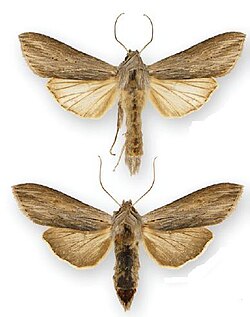Technical description
Cucullia umbratica is a fairly large species, with a wingspan of 52–59 millimetres (2.0–2.3 in). These moths have long, narrow wings giving a streamlined appearance. The forewings are dull brownish grey, the cell and space beyond are paler, with dull greyish buff. A fine black line runs from the base below cell. The usual lines and stigmata are ill defined. Orbicular is represented by two or three dark points, reniform by a curved black line at lower end. Slight black dashes are present before termen, above vein 3 and below vein 2, and a longer black streak appears above middle of vein 4. The hindwings of male are white, with the veins and termen narrowly fuscous, while in the female thy are wholly brown, with paler base. [5] The larva is grey or brown with black spots.
This species is quite similar to the chamomile shark ( Cucullia chamomillae ), but it shows two bands, one pale and one grey, on the fringe of the hindwing, whereas in the last there are three bands. [4]
This page is based on this
Wikipedia article Text is available under the
CC BY-SA 4.0 license; additional terms may apply.
Images, videos and audio are available under their respective licenses.




